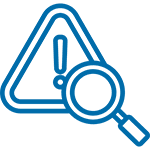Why you need to adopt a risk assessment framework in your business
A framework for risk assessment provides a structured set of guidelines for businesses to identify, assess, and manage risks and communicate them with the entire business operation. Here is why you should consider adopting one.
Why you need to adopt a risk assessment framework in your business
A framework for risk assessment provides a structured set of guidelines for businesses to identify, assess, and manage risks and communicate them with the entire business operation. Here is why you should consider adopting one.
The contemporary risk landscape is looking more and more unpredictable and volatile for businesses across the globe. In this environment, businesses must take all the steps they can to ensure that their risk resilience is maintained at a high enough level.
In striving to establish more risk-resilient business processes, certain initiatives have been recognised to contribute toward a robust risk management function. One of the most effective initiatives in this context is developing the framework for risk assessment.
These frameworks provide a more structured approach to risk management by detailing guidelines for risk identification, assessment, mitigation, and communication.
Popular frameworks include the FAIR (Factor Analysis of Information Risk) framework, the COBIT (Information Systems Audit and Control Association) framework, and the NIST (Risk Management Guide for Information Technology Systems from the National Institute of Standards and Technology) framework.
Let’s take a look at the benefits of having a risk assessment framework in place and how you can build one into your risk management processes.
Benefits of a risk assessment framework
Implementing a proper framework for risk assessment can be beneficial in multiple ways for your business.
Here are some of the most impactful benefits you can gain.
A more organised risk management function
A key benefit that a framework can provide is the increased level of organisation across risk management processes. This results in more cohesive team processes for risk identification and response, increasing your risk resilience.
Quicker responses to risk events
As frameworks for risk assessment help you continuously monitor, evaluate, and respond to potential risks and respond to them appropriately, the likelihood of unforeseen events causing disruptions becomes much lower across the board.
Higher standards of accountability
With a framework, you can increase the transparency of risk management processes and assign roles and responsibilities appropriately. This contributes to a higher level of accountability across the risk management function.
How to build a risk assessment framework into your risk management processes
Once you have decided on which framework to incorporate into your business, you can develop and implement your customised risk assessment methodology according to its guidelines.
Here are the steps you should take to establish your first customised risk assessment.
Identify existing risks
Identifying the potential risks that your business may be exposed to allows you and your internal teams to assess how they should be addressed.
You can establish an effective risk identification process and methodically engage your internal and external stakeholders to determine the likelihood and impact of potential risks.
Define a risk management plan
The information you extracted from identifying and assessing the risks can then be used to inform the development of a risk management plan.
Developing a risk management plan will involve categorising the identified risks into essential and non-essential risks that need to be managed for effective management.
Implement the plan
With the risk management plan developed, you can start implementing the mitigation strategies within it to manage your business’s risks.
This will involve a range of strategies that will contribute to avoiding, transferring, or mitigating risks depending on the nature of the risk and the asset/process it affects.
Analyse the results
Simply formulating the plan and managing risks isn’t enough, even if the strategies work out. Analysing the results is key to understanding the effectiveness of these strategies.
By analysing the results of your mitigation strategies, you can identify potential bottlenecks that might affect future risk management practices.
Review and improve processes
While even a static risk assessment process can help your business manage risks in the short term, if you’re interested in long-term resilience, continuous improvement is a must.
By reviewing and taking steps to continuously improve the quality of your risk management strategies, you can futureproof your risk management function.
Establish an effective risk assessment framework with SECTARA’s SRM capabilities
SECTARA eases the process of risk assessment by providing a simple, precise, and accessible platform for any risk practitioner.
The platform is designed to enable you to benefit from productivity gains through faster, standardised risk assessments that can be easily demonstrated to internal and external stakeholders through visualised, interactive dashboards.
Explore all of what SECTARA has to offer from the 14-day free trial. Click the button below to begin.
No credit cards or other commitments are necessary.
Some of the industries we serve
Government
Identify, monitor, and manage systemic risks associated with policy implementation, public safety, and national security with a scalable and configurable risk assessment solution.
Critical infrastructure
Obtain insights to identify and mitigate potential threats to critical infrastructure like energy, transportation, and communication systems through professional risk assessments.
Mining
Ensure safe, secure, and efficient operations and overcome common mining challenges like equipment failure and environmental hazards via a professional risk assessment solution.
Defence
Obtain a comprehensive view of potential threats to national and regional security and implement effective risk management strategies with military-grade risk assessment solutions.
Healthcare
Ensuring the safety of patients, staff, and other stakeholders while managing risks associated with medical procedures and data privacy through a configurable risk assessment solution.
Finance
Identify, monitor, and manage critical risks like market volatility and data breaches with a risk assessment solution to protect stakeholder assets and ensure regulatory compliance.
Consultancy
Help your clients make informed decisions about risk management by leveraging insights from a professional risk assessment solution that helps identify, address, and monitor risks.
Cybersecurity
Protect your digital assets with our advanced cybersecurity risk assessment solutions. Stay ahead of evolving threats and fortify your defences with comprehensive risk assessments.
Education
Identify and mitigate compliance, finance, operational, and reputational risks in processes such as student selection and regulatory adherence with professional risk assessments.
Experience the capabilities of SECTARATM first-hand. Sign up for our 14-day free trial today.
Start your 14-day free trial
What you get with our free trial
2 users (Account Admin, Org & BU Admin, Assessor, Viewer)
2 concurrent assessments
2 organisations & business units
In product training
The ability to export assessments to MS Word
MS Excel treatment plans
White label SECTARATM platform
White-label exported documents
Audit records
Experience the capabilities of SECTARATM first-hand. Sign up for our 14-day free trial today.
What you get with our free trial
2 users (Account Admin, Org & BU Admin, Assessor, Viewer)
2 concurrent assessments
2 organisations & business units
In product training
The ability to export assessments to MS Word
MS Excel treatment plans
White label SECTARATM platform
White-label exported documents
Audit records
Start your 14-day free trial
Frequently Asked Questions
The 5 principles of risk assessment are;
- Identify hazards
- Assess risks
- Control the risks
- Record results
- Review the controls
The following 5 components must be incorporated into risk management components;
- Risk identification
- Risk analysis
- Response planning
- Risk mitigation
- Risk monitoring
One of the most popular frameworks of risk management is ISO 31000, developed by the International Organization for Standardization.







